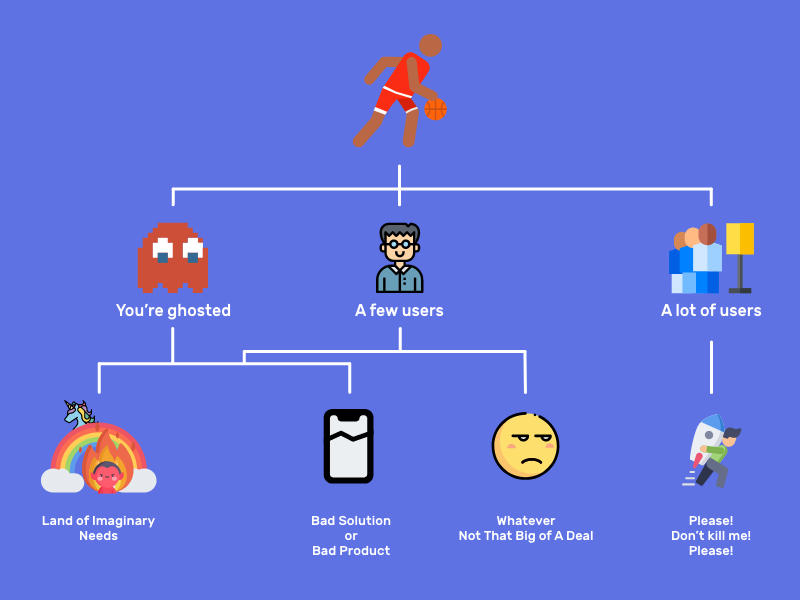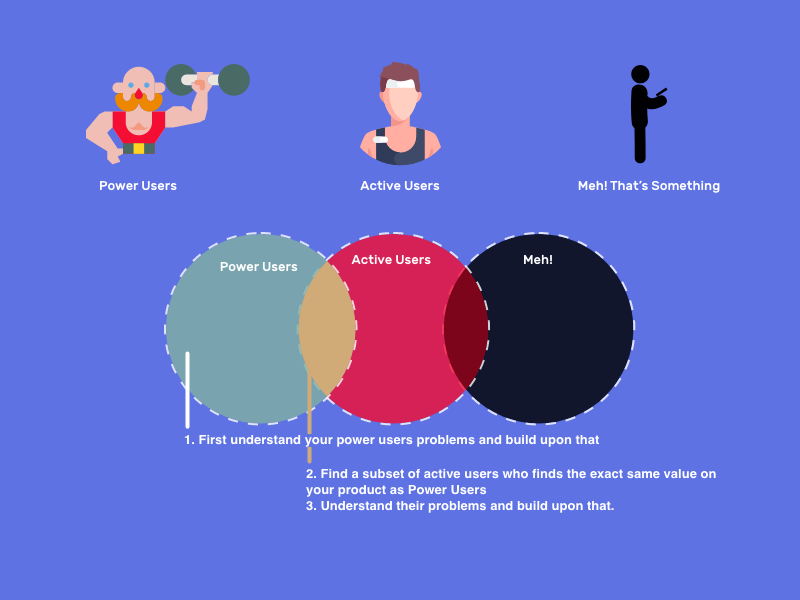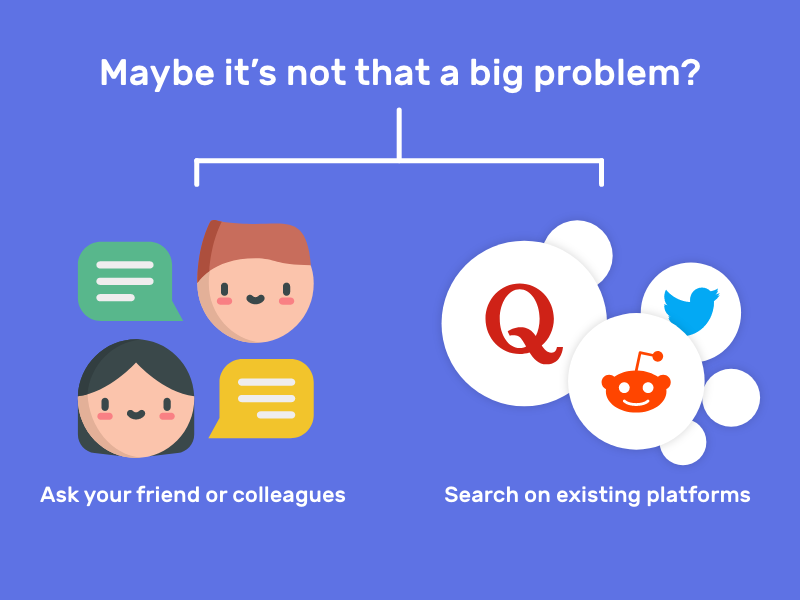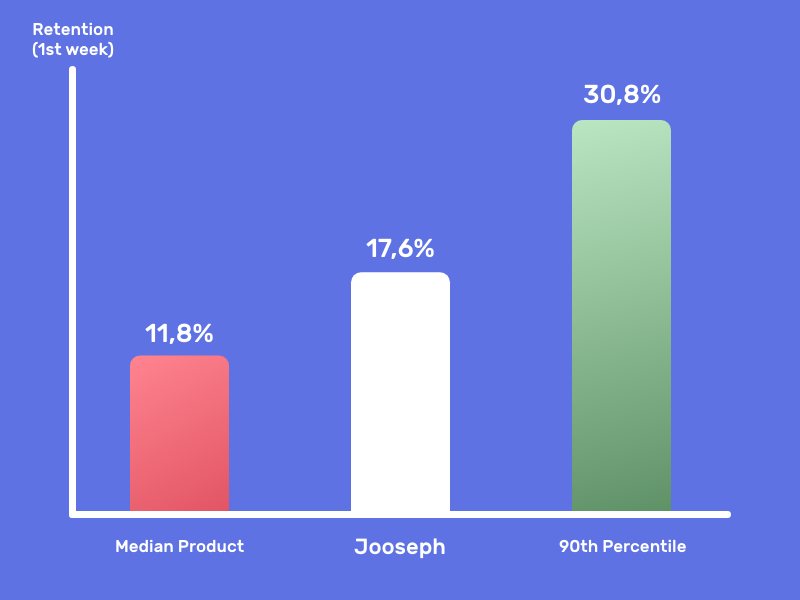Should You Pivot or Not?
Hey everyone,
I didn't share this piece yet, which I create an outline on when and why to pivot. So, I would like ask your opinion on this, do you find it valuable and since I am not a native speaker, I really appreciate it if you let me know how can I improve this copy. Thanks in advance.
Should I Stay or Should I Pivot?
An outline that might be helpful for you to answer when and why to pivot or not to pivot.
This was the question that haunts me at nights. I was trying to figure out the answer so hard that I forgot, answers can change from instance to instance. Therefore, I’ll try to explain my experience on questioning the pivoting, try to cover “When” and “Why” questions and give examples. Also, I’ll share with you a list of my favorite resources about pivoting at the end.
First I want to give you a little bit of context. We’re building a place for following, sharing and storing curated collections for learning and finding great contents. Basically, playlists for learning. We were frustrated by the SEO pumped content that wastes our time, so we started building a place where you can dodge from them and find high quality content with a human curated list of links to great content.

For the last couple of weeks, I have been searching for resources about “Pivoting”. It’s a hard decision to be made, whether pivot or not. Also, there are too many variables in terms of deciding pivoting. You have to take a lot of different things into account such as product-market fit, market-solution fit, your metrics, benchmarks, thresholds, value of your product and your opportunity cost.
That being said, I will try to be as concise and focused as I can be. I will try to create the post that I was searching for the last couple of weeks. Still there’ll be a lot of 'what if’s and 'let's say’s in this essay. Also, I am assuming you know basic terms like “product-market fit”, “Benchmark”, etc.
Another point, I don’t even consider talking about your passion for the thing you’re working on. If you don’t have passion for the problem, product or if you don’t like your users, I believe you should pivot it but I won’t cover this aspect since it’s too subjective.
Before starting, I want to explain concisely what I mean by pivot because there are a lot of different ideas about what it means. Pivoting is making a significant change in your solution or completely changing your idea. What I don’t mean by pivot is changing your user subset or adding new features.
Path to Product Market Fit
You can’t deny that product-market fit and pivoting are highly correlated subjects. If you’re not on a path to product market fit, it’s a good sign that you should pivot it. But how can you understand if you’re off track. There are a couple of reasons that you might be misleading. I’ll explain following two,
- There is no market need
- Product doesn’t delivers the solution
I think most of the time the question of pivoting branches out from these two aspects. Therefore, I’ll try to build my structure upon these two aspects and make a reasoning with them on why we didn’t pivot it.
Does problem exists?
It’s a fairly easy concept to understand. If there is no problem to solve probably there is no need for your solution. One of the ways to not fall into the trap of building something people don’t want is to build something for yourself. It's much easier to build something for your problem than it’s to build some made up non-existent problem.
I believe the easiest way to determine whether the problem exists or not is by asking users basic questions about their real life experiences in the context of the problem. For instance, in our case it was asking our potential customers whether they are having problems finding high quality resources or not. The answer indicated that it was hard to find great resources and it was time consuming to do so. Also, building a landing page about your value proposition and collecting emails could be a simple way to measure this.(Sometimes it could be misleading but that’s best I have)
We all know that is not pivoting, you can’t pivot if you barely started. Therefore, let’s say you already passed all these steps and built a product, but you feel like you have to reconsider whether the problem exists or not. In other words, you want to be sure that you didn’t fool yourself. In this case, sending emails to your existing users for an interview to ask about their experience and the main benefit they get out of your product is a great starting point.(*You can also call them.)
This can end up in a couple of ways,
- Your users ghosted you
- Little subset of your signups answered (as little as 1%)
- They get the exact same value you propose.
- They found another value in your product.
- A lot of them answered
- They already start demanding for features (Why the f* are you here, go back to your rainbow land[1])
- They found another value in your product.
- There are a couple types of different values.

Let’s start explaining from the ends of the spectrum; Ghosting and A lot of users answered. Those are easier to understand and interpret, the hardest one is in the middle.
You’re ghosted
You’re ghosted by users, what happens now. Do whatever you do when you are ghosted by a date, stalk them and beg for their love. Please, don’t do that to your dates! Yet, you can try a couple of times to reach-out to your users. Let’s say they still ghosting you.
There could be two reasons for that,
- No market need
- Your product does not solve the problem and has a bad first impression. (Next Chapter)
I’ll explain the second one in the following chapter; but for the first one, being ghosted is a really good indicator that you have stepped into land of imaginary needs. One of the good ways to convince yourself that you’re solving a real problem, when you have ghosted by your users, is to search the problem on existing platforms. If there is a problem, probably there is somebody complaining about it. It’s easier than ever to complain about something, so go to Quora, Reddit or Twitter. Search for posts, questions and stories about the problem or create a post on these platforms whether they encounter this problem or not. If you don’t get what you are looking for, then it’s time to move on, there are plenty of fish out there.
If you get what you want, probably your product does not solve the problem. I’ll explain this one in the next chapter.
Filled up inbox
In an unexpected way, a lot of people answered back even though there wasn’t so much retention for your product. Now your inbox is filled up with user emails and they are expecting you to build the things they want. You know that at least you’re probably working on something that people want, the reason that takes you here and makes you think about pivoting is buried under one of those emails.
How could you find it?

I think one of the best ways to do that is implementing following logic,
- Find the most active users or the ones get most out of your product = Power Users
- Understand their problems and the main benefit they take out of your solution
- Build upon that
- Find average active users that takes exactly same main benefit as power users
- Understand their problems and build upon that
Let’s say they found another value in your product and they are hacking your product for solving another problem. It’s a thought experience to have because sometimes these hacks lead to big breakthroughs and help you to find a really great solution for an unknown existing problem. In other cases those users are only spammers and it can be hard to understand the difference. How could you understand you did catch one of those breakthroughs? I don’t have a great example for this, but I am assuming that you can try to evaluate the long term value of that behavior or product hijack.
For instance, in our case it was obvious, people were trying to promote their sites and creating curations only from their own content. This behavior has most likely no value for our users who consume those content. I don’t have any example or experience for the other part of this case.
What if there are couple of different types of values that users get from your product. Everyone has their own ecole, mine is simplicity. What would I do in that case? Probably, I will go with the one value and try to build upon it. I would use the logic above and try to build a single value first for my power users. You can always disagree.
Building for yourself and couple of others
You’re staring at your inbox and expecting for more users to answer your emails. This is not a good sign but in the end, you’re building for yourself and a couple of other early adopters. If there are couple of users consistently using your product and answering your emails, you can build something upon them.
I believe this is the hardest one, that’s why I’ll answer this with much less confidence so take my answers with a grain of salt.
I think, there could be three reasons for that;
- Maybe it’s not that big of a problem.
- Maybe it’s not a problem (We already cover this one in no market need).
- Your product isn’t there yet. (Next Chapter)
How could you understand you’re picking up a really big problem. I only know two ways for this and one is more subjective and the other is more consistent to do so. Let’s start with a consistent one, you need to understand how frequently happens this problem and how bad they want to solve this; I would go into two ways for understanding,
- Reach out your peers, friends or colleagues and ask them
- Ask existing communities; We’re back to Quora, Twitter, Reddit, Indie Hackers and more…

So you know some of the places you can go but how could you understand what type of problem is this? Does someone’s hair is on fire or do they just get bitten by a mosquito? Here’s couple of things I would do,

- I would ask them how many times per a day/week/month or etc. they take this action.
- How many times do they encounter this problem?
- How much are they paying for existing solutions?
- Compare your solution with the existing one and decide how big is the threshold between your solution and existing ones. ( Even if there are no direct solutions, people probably trying to solve the issue)
What is the more subjective way to understand this? If you’re the one who has this problem, you can always ask yourself how bad you want a solution. How much life would be miserable for you without this product.
The reason I call this approach subjective is not only because it involves your opinion and one data point but it involves your idea as an entrepreneur. Most of the time entrepreneurs can be delusional and it’s not necessarily bad but try to be as honest as possible with yourself. So, asking yourself the questions above is better than just asking yourself how bad you want this. Probably, you want it so bad that makes you want to live a miserable life of an entrepreneur*
*(Miserable only from the perspective of standard viewpoint. C’mon, you can’t disagree with me. We have a word for only living on ramens and being profitable: Ramen Profitable. I would be miserable if I wouldn’t try to do what I do.)
Next Chapter: Shortcoming Product
This is the next chapter and the part where we’ll try to find out about product pitfalls that takes you here. One of the indicators we covered that helps you foresee pivoting was understanding the market need or problem existence. The other one is understanding where your product stands. I know three product aspects that makes you think about pivoting,
- Your product does not delivers the solution
- Your product does not delivers the value yet (different from delivering solution)
- Your product falls short on threshold
Before going into these aspects, I think you should understand where does the value of your product comes from. There are different types of products which brings value from different stand points. For instance, your product could be valuable as solo such as an SaaS app or your product can be valuable as an intermediary such as marketplaces. My point is there are products which are valuable as a single player games, multiplayer games and both simultaneously.
Couple of those and examples,
Your product can only be valuable if there is enough valuable content or option in it. Marketplaces,
- Two Sided Content Sites and Streaming Services are great examples of this.
- Medium is an example of this which has double sided supply and demand options. Readers can write and writers can read, but without enough good content, there is no substantial value on Medium.
- Netflix is an example of this which has single sided supply and demand options. Only Netflix can put up with the content.
- Airbnb is another example, there has to be enough hosts and visitors for the marketplace to create value which also comes with chicken in the egg problem.
Your product can only be valuable if the subset of groups are using it simultaneously.
- Social Networks and Messaging apps are generally great fit.
- Facebook is a canonical example of this. It’s only valuable if my friends are using it.
- Linked is another example which has a slightly different network effect. It doesn’t matter if only my network is on that also my networks’ network should be on it to help me expand my network.
Your product is valuable by itself. Most of the SaaS products are great examples of this.
- Intercom does not need any network effect or content to create a value, it’s product is valuable by itself for most of the enterprises.
Those are the main value types of products that come to my mind. There are also products that increase their value when they have more integration which are platforms. Platforms also have network effects but I believe most of the time platforms have single player value builded in it. Since we have focused on pivot and delivering value. It seems to me those are delivering value even without the need of network effect or content.
Does your product solves the problem?
This might be the reason why you don’t get a reply, feedback or traction from your user. For someone who is an outsider to your project, it's easier to declare that the product doesn’t deliver any solution, but they might know too little about the problem you’re trying to solve. If those comments do not come from someone who has the problem, it can be misleading.
However, what should you do to understand this then? I am sorry but I don’t have many suggestions for this. If you’re building a product for yourself or peers, the best way to understand this is to ask them and yourself whether this would solve your problems or not.
Does your product delivers the value?
This is a different point than solving the problem but this causes you to not solve the problem. The main difference between the broken solution and not delivering the value is about the value you build in your product. For instance, your product can solve the problem but if value comes from content in the product, basically your software has no value without great content in it. Youtube is a great example for this, there is no value to have a streaming service that has bad or no content on it.
In cases like this, if you’re sure that your product is not fundamentally broken but there is another factor that directly affects the value you propose, like Facebook, LinkedIn, Spotify or Youtube, I believe there are two ways to overcome this problem.
- Push through to that equilibrium.
- Build something that takes you there such as virality or single player mode.
I think doing both is vital but you might survive doing one of those.
Pushing through that equilibrium sounds so idiosyncratic, you are probably pushing it already but what I mean by that, there are several tactics you can do. You can start with a subset of a market, a very popular example of this can be Facebook’s initial users which were only Harvard students.
Another thing you can do is “fake it till make it” until you get the initial pump you need. For instance, you can create your own content or you can be the driver/host. This will give you time to deliver your value and time to create your minimum viable amount of pump you need. Also, it makes you to understand basics of your business. Best example that suits in this category is Reddit. In the early days founders have created several fake accounts to make their site seem more active. Another great example is DoorDash, founders were the drivers itself for first couple of months.
There is another way you can try before pivoting which I believe you should try to do simultaneously with the first one. You can build a single player mode and virality on your product. What do I mean by single player mode is a feature that your users can benefit without having any other values you propose. For instance, Instagram had great filters and has still those filters but in the first couple iterations those filters were the way for attracting and sustaining first users. That single player mode let people share their photos on other platforms and on instagram with great filters.
You can also build virality on your product to overcome this problem. Actually I believe you must build virality but before pivoting consider building virality if your product falls under this category. Whatsapp has your address book which you could invite your friends and family into the platform.
Fall Short on Threshold
Last but not least, falling under the threshold. This is the one which you have most control on and it mostly depends on your skills. Let’s dive into it. So you decided your problem or product does not fall under none of the other indicators. You’re in a situation either Jump, Pivot or Persevere. There is one more thing you can check which is not reaching standard quality.
It is a way of your users telling you that existing solutions are better equipped than your product. In this case you should check the threshold of your market. For instance, you’re building a video streaming product. I believe, you would probably choose a subset of users that youtube does not target, so in those cases you must solve the problem better than for that subset of users initially. This can be a reason you’re thinking about pivoting, but instead maybe you only need to create a better product. This threshold varies by the products out there. One of the ways to determine pivot or not is understanding that threshold. If there is not a really great subsidiary solution for your problem then probably the threshold is really low. If there are solutions like Netflix, Disney Plus, etc. probably the threshold is pretty high.
Also, it is highly correlated with your benchmarks and how much space do you have to iterate/improve. There comes your opportunity cost and skills to improve. If you’re new, let’s say it has been 1 month since you started, you have probably still a lot of space to improve and if you have related skills, you should probably persevere. On the other hand, you feel like you have a high opportunity cost on this, you might want to change your idea and jump. I never felt like I had a high opportunity cost.

Let me give you our experience on this. Our first week retention rate was 17.6% and the benchmarks we found for our industry with the same kind of product was relatively high which is 31% for the 90th percentile and 11% for the median. It has been more than a 1 months since we started so we decided not to pivot because when we looked at our product and the others, there was a lot of space to improve.
In the end ( It doesn’t even matter)
In this piece I tried to explain the points and indicators that make you think about pivoting. Just looking at someones metrics and deciding whether they should pivot or not is a hard tell. I believe you need a much more holistic view of the circumstances to answer the question of pivoting and for that holistic view you don’t need to spend years of time.
First point I touched on was whether you’re solving a real problem or not. For understanding that, you can ask your users or potential users about their existing experiences. If you are convinced that they have this problem but still they don’t use your product and you don’t get a lot of feedback or your user ghosts you. It’s a good sign that your product doesn’t solve this problem, delivers promised value or didn’t pass the average threshold.
This takes me to the second point, if your product doesn’t solve the problem you want to pivot your product. On the other hand if it solves the problem but the value of the product depends on some outside factor than software which can be active users and content created, probably there are places you can improve so you might want to push it. At last, everything might be fine but the product threshold can be really high because of the existing subsidiaries. If you find yourself in that situation, I suggest you consider your skills and opportunity cost because you’re probably not dealing with some untapped market but instead you’re trying to build something 18x better.
I hope this framework, experience, guideline or whatever you call, helps you to answer some hard questions. If you hate my sense of humor press like button.
You can find our hand picked curated list of really great articles, videos and podcasts on Jooseph about the subject I just talked about, here’s some collections that can help you broaden your understanding on Network Effects, Pivot and Product-Market Fit. You can sign up from here

great piece of content thank you so much!